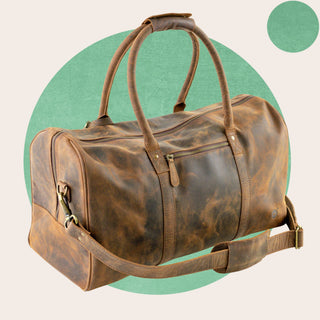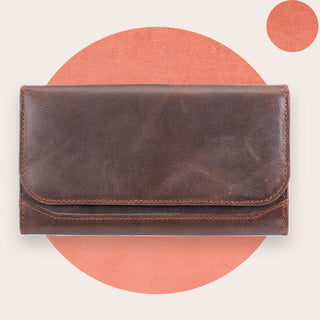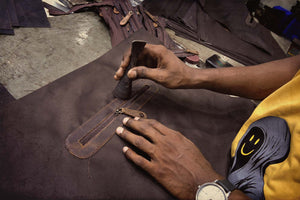Many people love the look, feel, and smell of leather. If you’re in the market for a new sofa, wallet, jacket, journal, or leather duffle bag, you may have your mind set on gorgeous leather. However, if you’re like many, you might also have some questions about the real leather vs faux leather differences. What are the different leather types? What is PU leather, and how does it differ from an authentic leather product? Continue reading, and we’ll explore all of these questions to help you understand the fundamental difference between genuine leather and faux leather.

Real Leather vs Bonded Leather vs Faux Leather
As you’re shopping for a new piece of furniture or accessories, you’re likely to see three different leather types. These include genuine leather, bonded leather, and faux leather. Despite the fact that all three of these materials include the word leather in their name, they are all actually quite different.
Genuine Leather
What is genuine leather? Genuine leather is real leather that is made from animal hides. While cow hides are frequently used to make real leather, the hides of other animals—including goat, moose, crocodiles, snakes, deer, buffalo, and sheep—can also be used to make genuine leather products.
There are different classifications for real animal leather. Full grain leather and top grain leather are the two highest quality options. Full grain leather—the crème de la crème of leather—is made from the full animal hide. Often used for luxury items, this type of leather is made from a blemish-free animal hide that did not require any additional buffing or sanding once the hair was removed.
While not quite as high-end as full grain leather, top grain leather is also a high-quality product. To make top grain leather, the uppermost layer of the animal's hide is shaved before the leather is tanned. You may also hear top grain leather referred to as split leather. Top grain leather is a popular choice for making leather wallets, handbags, sachets, and briefcases because it is thinner and a bit easier to shape than full grain leather.

Bonded Leather
Bonded leather is made using leftover leather scraps. These scraps are combined with a polyurethane binder, rolled together, and adhered to a paper backing. Sometimes bonded leather manufacturers will add a polyurethane coating to enhance the appearance of the bonded leather and make it look more similar to genuine leather.
A major real leather vs bonded leather difference lies in the percentage of actual leather contained in each product. While natural leather is made using 100% leather, bonded leather typically only has about 10 or 20% genuine leather.
Faux Leather
What is faux leather? Is faux leather real leather? Faux is a fancy way of saying fake or artificial. Faux leather is just that—fake leather. It is made without animal products, which is why you’ll sometimes see faux leather called vegan leather. Rather, a plastic polymer, PU (polyurethane) or polyvinyl chloride (PVC), is used to make faux leather. If you see something labeled PU leather, PVC leather, synthetic leather, or pleather, these are all just different ways to say that the item is made from faux leather.
Another term you may hear used is vegan leather. So, what is vegan leather? Vegan leather is just another term used to refer to faux leather since it is made without animal skin or any animal products.
What are the differences between real leather, bonded leather, and faux leather?
Now that we’ve shared a brief description of each type of leather, let’s take a closer look at the genuine leather vs bonded leather vs faux leather differences as they relate to durability, texture and appearance, sustainability, maintenance, and cost.
Durability
One of the main real leather vs bonded leather vs fake leather differences relates to the durability of each material. Cow leather and other types of genuine leather are known for their exceptional durability. Natural leather does not crack or peel over time, which is not the case for PU or bonded leather.
Bonded leather is the least durable choice because the mixture of scrap leather and polyurethane is much more likely to peel or flake off its paper backing. So, if you’re looking for a leather jacket, sofa, journal, or any other item, choose real leather if you want a durable and long-lasting product.
Look, Feel, and Smell
The look, feel, and smell of real leather also differs from that of faux or bonded leather. Animal leather offers a very natural appearance with natural imperfections that make each piece unique. The texture of real leather is very smooth and supple.
When you think about the question, “what is faux leather made of,” it should make sense that it won’t be able to mimic the exact look and feel of natural leather. While the plastic polymers used to make PU leather can come close, the exact texture and look of faux leather just doesn’t compare. However, as a synthetic material, there are more color options available with PU leather.
The faux leather vs real leather smell is also different. While PVC leather has a plasticky smell, real leather offers a natural and pleasant scent. Bonded leather sometimes has a bit of that true leather smell, but it is often mixed with some other scents from the polyurethane binder that was used.
Eco-Friendliness and Sustainability
While those looking for vegan leather may not be fans of genuine leather made from animal hides, there is a bit of a debate about real and faux leather and which material is the most eco-friendly and sustainable option.
Real leather is expensive to make, and the production process does require a lot of time and resources. However, while the faux leather manufacturing process requires fewer resources, the plastics used are not eco-friendly. They will not decompose, meaning they will continue to add to the amount of waste in our landfills.

While bonded leather recycles leather scraps, chemicals used to make it can be released back into the atmosphere over time.
Cleaning and Maintenance
PU leather is easier to clean than real leather. Unlike genuine leather, PU leather won’t absorb liquids. A real leather couch or leather chair, for example, can stain more easily than one made from PU leather.
You’ll also need to make sure to treat your genuine leather products about two times a year to make sure they don’t get too dried out. Always clean real leather using approved cleaners and avoid using anything abrasive.
Price
Finally, one of the biggest real leather vs faux leather differences relates to the price. The manufacturing process for genuine leather is much more involved than that of faux leather. This results in a higher quality product, but that quality also comes at a premium. If you’re shopping for leather furniture or other items, be prepared to spend more for a genuine article compared to something made with PU leather. Bonded leather will likely be the least expensive because of how thin it is compared to even faux leather.
Real Leather vs Faux Leather: Which is Right for You?
Now that you’ve had a chance to learn more about real leather vs faux leather or bonded leather, you should have the information you need to decide which material is right for you. Consider your personal preference and the facts shared above before your next shopping trip.
FAQs
Is faux leather better than real leather?
There are pros and cons to consider when comparing a PVC leather fabric (faux leather) with genuine animal leather. While faux leather is stain and fade resistant and comes in a wider range of color options, it can’t match the unique feel and durability offered by real leather.
Does faux leather last longer than real leather?
No, faux or vegan leather products will not last as long as those made from real leather. Over time, faux leather will begin to break down or crack.
What are the disadvantages of faux leather?
When compared to animal leather, there are a few disadvantages of synthetic leather. For example, faux leather is not as durable, hypoallergenic, or breathable as real leather. Additionally, the process of manufacturing faux leather yields much higher amounts of environmental waste compared to the production process for genuine leather products.



